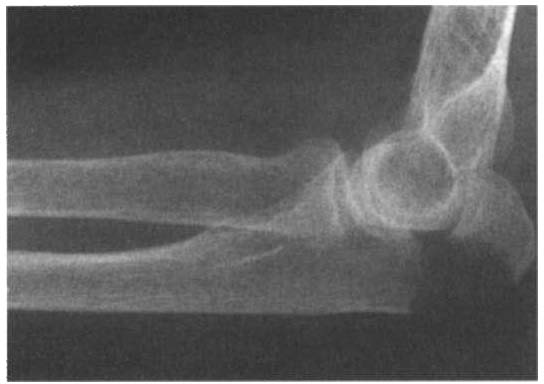i bc27f85be50b71b1 (58 page)
Read i bc27f85be50b71b1 Online
Authors: Unknown

the result of a fall.' An intercondylar fracture (i.e., T- or V-shaped
condylar fracture) is the most common distal humeral fracture in
adults. A direct impact of the ulna against the trochlea forces the
condyles apart." This is common after an MVA or high-impact fall.
Treatment consists of (1) immobilization, followed by early ROM for
a stable fracture; or (2) ORIF or total elbow arthroplasty (TEA) for
severely comminuted intra-articular fractures. Late complications
include hypomobiliry, nonunion, malunion, ulnar neuropathy, and
heterotrophic ossification.
Olecranon fractures (Figure 3-"11) result from direct trauma to a
Aexed elbow or a fall on an outstretched hand. Severe comminution
of the olecranon is associated with humeral fracture and elbow dislocation. Late complications include loss of terminal elbow extension, painful hardware, and post-traumatic arrhritis.J2






MUSCUIOSKF.I £TAL SYSTEM
187
A
B
Figure 3-10. A. hacture of the medial epIcondyle. Note the "lnar nerve nuts
ImmedIately posterior to the fracture. B. The brachial artery is at risk lit
supracondylar fractures. (W"tl1 permISSIon from A Ullwm, K Jones reds).
Emergency OrthopaedIcs and Trauma. Boston: Butterworth-Hememann,
1995;126.128.)



188
Acm'E CARE HANDBOOK FOR I'HYSICAL n-IERAPISTS
Figure 3-11. Fracture o( the olecranon. (\Vith permission (rom A Unwin, K
Jones /edsJ. Emergency Orthopaedics and Trauma. Boston: Butterworlh
Heil1emann, 1995;130.)
A fall onto an outstretched hand wirh a pronared forearm can
cause a radial head or neck fracture (Figure 3-12). Associated injuries
include elbow dislocarion and disruprion of the interosseous membrane, medial collareral l igamenr, or wrist fibrocarrilage.32 Complications of stable radial head fracture include residual pain and f. I
A
B
Figure 3-12. Fractures o( the radial neck. A. Displaced. B. Displaced and
angulated. (\'Vilh permission (rom A Unwin, K Jones reds/. Emergency
Orthopaedics and Trauma. Boslon: Buuerworth-Heinemoll1l, 1995; 130.)


MUSCULOSKEU:.IAL SYSTEM 189
hypomobility, whereas unstable radial head fractures are associated
with loss of fixation, nonunion, and painful hardware.32 Olecranon
and radial head fracture management is presented in Chapter Appendix Table 3-A.15.
Forearm Fractures
Fractures of the shaft or distal portion of the radius or ulna occur
from a wide variery of direct trauma including falls, SPOrtS injuries, or
M VAs. Owing to the high-energy impact, the fracture is usually displaced, affects an adjacent articulation, and involves a wrist or distal humeral fracture.1 Management for forearm fracture is summarized
in Chapter Appendix Table 3-A.16. Complications of forearm fracture include compartment syndrome, reflex sympathetic dystrophy, nonunion, malunion, radial nerve injury, post-traumatic arthritis, and
hypomobility of the elbow, forearm, and wrist.'·29